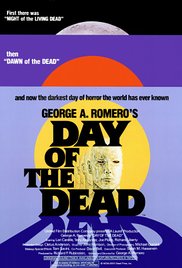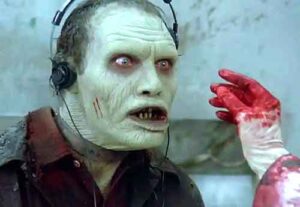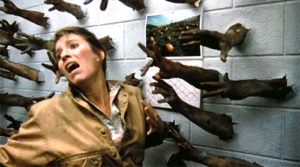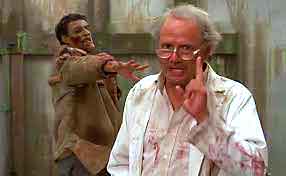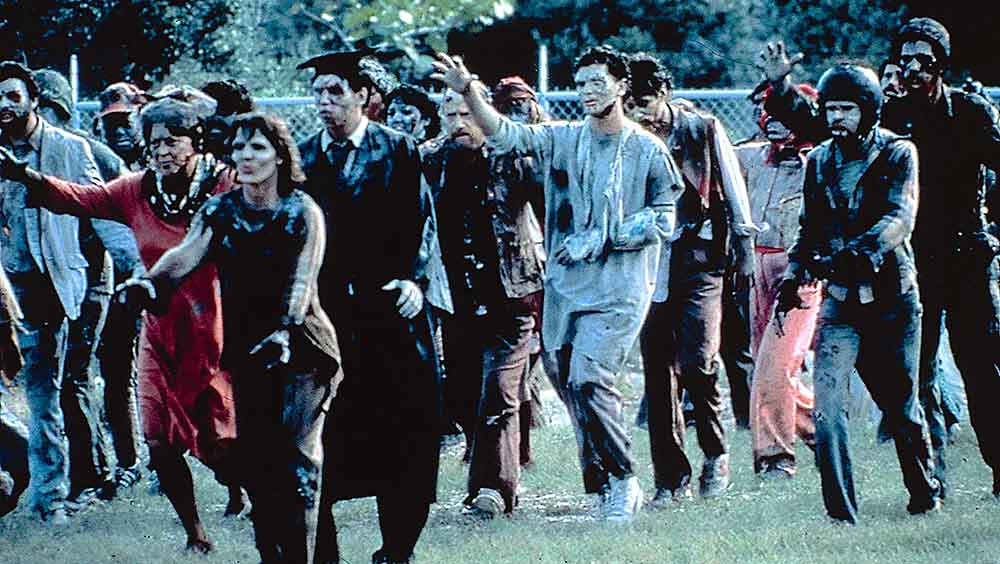To many horror fans DAY OF THE DEAD, the third in George Romero’s “Dead” movie saga, is a genre masterpiece. Not me!
DAY OF THE DEAD, which followed NIGHT OF THE LIVING DEAD and DAWN OF THE DEAD, was initially conceived as an action-horror epic complete with zombie soldiers and a heavily stratified underground society. Unfortunately that version proved too costly and so George Romero was forced to pare his script considerably, meaning the zombie armies were jettisoned and the underground society whittled down to a dozen or so people trapped in a military bunker. An early draft of the script is included on the Anchor Bay double-disc DVD release, providing a tantalizing glimpse at what might have been while casting a none-too-flattering shadow over the scaled-down results.
The film in any event was released in the summer of 1985 without an MPAA rating, as was Romero’s mega-successful DAWN OF THE DEAD, and did little-to-no business. That doesn’t surprise me, considering it’s a crummy movie, although Romero and co. can point to an outside factor: the release of Dan O’Bannon’s RETURN OF THE LIVING DEAD two weeks into DAY OF THE DEAD’S theatrical run, which effectively obliterated it commercially. RETURN OF THE LIVING DEAD was not in any way sanctified by Romero (it was initiated by NIGHT co-writer John Russo, although he, like Romero, ultimately had no involvement in the production of RETURN—a long and complicated story), but viewers and even a few critics were confused on that point, believing it a legitimate sequel to NIGHT OF THE LIVING DEAD. Whatever it is, RETURN OF THE LIVING DEAD is far more exciting than the present film.
A scientific team is engaged in a last-ditch effort to control the zombie plague that has taken over the Earth. At the moment they’re scouting Florida’s Fort Meyers in search of non-zombified survivors; they’re overrun, though, by bloodthirsty zombies, and end up taking shelter in an underground military compound.
There the compassionate Sarah and her companions are confronted by the megalomaniacal Captain Rhodes, who lords over everyone in the place. Before long the scientists and military folks are at each others’ throats, while the wild-eyed Doctor Logan makes a scientific breakthrough by creating an affectionate zombie he names Bub. Bub has a hazy memory of his pre-zombie life, enjoys listening to music on a walkman and plays with a razor. But what nobody realizes is that Logan is secretly plying Bub with the one element zombies desire above all else: human flesh!
Trouble begins to spread throughout the compound as a scientist loses control of a zombie specimen and tensions between the scientists and military personnel reach the breaking point. One man tries to escape in the elevator leading to surface level; when the elevator is lowered back down, it disgorges dozens of out-of-control zombies, leading to an orgy of bloodletting and flesh chomping.
In DAY OF THE DEAD George Romero abandoned the loose, improvisational shooting style of his previous films in favor of a more by-the-book approach. This explains the impersonal feel of the proceedings, which lack the energy and flamboyance of most of Romero’s other work. Despite some effective scenes here and there, DAY is closer to the innumerable imitation zombie flicks that followed in the wake of the original DAWN OF THE DEAD than an honest-to-goodness Romero picture. It doesn’t help that his script, in its pared-down form, is plain dull; yes, the zombie gore mash that concludes the film is a blast, but it doesn’t occur until the final twenty minutes. Until then we’re stuck with (mostly) bad actors schlepping around a confined space.
Lead actress Lori Cardille is reasonably effective, but all the other mortal roles are overplayed, with Howard Sherman as Bub the experimental zombie delivering the best performance by far. For that matter, the elaborately made-up zombies in this film are probably the most impressive of any of Romero’s living dead flicks, played by folks ranging from Fangoria editor Bob Martin, THE DEAD NEXT DOOR director J.R. Bookwalter and THE ZOMBIES THAT ATE PITTBURGH author Paul Gagne.
Which bring us to the make-up effects by Tom Savini, the one area in which this film really shines. The final twenty minutes, in which the climactic zombie mash occurs, contain some of the most astounding bloodletting, arm chopping and intestine pulling of any horror movie, and confirm Savini’s status as the reigning FX genius of the eighties—and beyond.
Vital Statistics
DAY OF THE DEAD
Laurel Entertainment
Director: George A. Romero
Producer: Richard P. Rubenstein
Screenplay: George A. Romero
Cinematography: Michael Gornick
Editing: Pasquale Buba
Cast: Lori Cardille, Terry Alexander, Joe Pilato, Richard Liberty, Howard Sherman, Philip G. Kellams, Taso N. Stavrakis, Gregory Nicotero, John Amplas

